The Innovators: How a Group of Hackers, Geniuses, and Geeks Created the Digital Revolution
by Walter Isaacson
Draw Your Big Idea: The Ultimate Creativity Tool for Turning Thoughts Into Action and Dreams Into Reality!
by Nora Herting and Heather Willems
The Vignelli Canon
by Massimo Vignelli
Technique in Nonfiction: The Tools of the Trade
by Steven Darian
Free Agent: The Independent Professional’s Roadmap to Self-Employment Success
by Katy Tynan
Technical and Professional Communication: Integrating Text and Visuals, Edition 1.1
by Dolores Lehr
The ABCs of How We Learn: 26 Scientifically Proven Approaches, How They Work, and When to Use Them
by Daniel L. Schwartz, Jessica M. Tsang, and Kristen P. Blair
The Elements of Blogging: Expanding the Conversation of Journalism
by Mark Leccese and Jerry Lanson
Human Computer Interface Technologies for the Motor Impaired
by Dinesh K. Kumar and Sridhar Poosapadi Arjunan
Scientific and Technical Translation
by Maeve Olohan
Start Differently: How to Inspire Your People, Turn Conflicts into Cooperation and Run Successful Projects
by Richard Bois and Gloria Hunter
Teaching Communication and Media Studies: Pedagogy and Practice
by Jan Fernback
The Master Communicator’s Handbook
by Theresa Erickson and Tim Ward
Academy-Industry Relationships and Partnerships: Perspectives for Technical Communicators
by Tracy Bridgeford and Kirk St.Amant, eds.
The Routledge Handbook of Strategic Communication
by Derina Holtzhausen and Ansgar Zerfass, eds.
Design for the Mind: Seven Psychological Principles of Persuasive Design
by Victor S. Yocco
Herbert Leupin: Poster Collection 28
by Bettina Richter, Hermann Strittmatter, and Museum für Gestaltung Zürich, eds.
Value Creation and the Internet of Things: How the Behavior Economy will Shape the 4th Industrial Revolution
by Alexander Manu
Facilitating Learning with the Adult Brain in Mind: A Conceptual and Practical Guide
by Kathleen Taylor and Catherine Marienau
Risk Communication and Miscommunication: Case Studies in Science, Technology, Engineering, Government, and Community Organizations
by Carolyn R. Boiarsky
Please Make This Look Nice: The Graphic Design Process
by Peter Ahlberg
Deep Text: Using Text Analytics to Conquer Information Overload, Get Real Value from Social Media, and Add Big(ger) Text to Big Data
by Tom Reamy
Clinical Communication in Medicine
by Jo Brown, Lorraine M. Noble, Alexia Papageorgiou, and Jane Kidd, eds.
Best Practices for Knowledge Workers: Innovation in Adaptive Case Management
by Layna Fischer, ed.
Successes and Failures of Knowledge Management
by Jay Liebowitz, ed.
There’s Not an App for That: Mobile User Experience Design for Life
by Simon Robinson, Gary Marsden, and Matt Jones
The Innovators: How a Group of Hackers, Geniuses, and Geeks Created the Digital Revolution
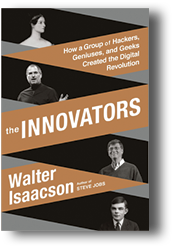 Walter Isaacson. 2014. New York, NY: Simon & Schuster. [ISBN 978-1-4767-0869-0. 542 pages, including index. US$35.00.]
Walter Isaacson. 2014. New York, NY: Simon & Schuster. [ISBN 978-1-4767-0869-0. 542 pages, including index. US$35.00.]
In 1843, Ada Lovelace, mathematician and daughter of Lord Byron, while working with Charles Babbage on an early attempt to build a mechanical calculator, envisioned the eventual existence of what we now call a computer, a universal programmable machine capable of taking on any task.
As it turned out, making Ada’s vision manifest took more than a hundred years and the collaborative contributions of dozens of mathematicians, physicists, mechanical and electrical engineers, materials scientists, mechanics, and visionaries. Exploiting the possibilities the computer opened up—the Internet and the rest—took the contributions of many others, including a motley assortment of entrepreneurs, gamers, hackers, and social visionaries. In The Innovators: How a Group of Hackers, Geniuses, and Geeks Created the Digital Revolution, Walter Isaacson tells their story.
Isaacson has written a number of well-received books, including biographies of Benjamin Franklin, Albert Einstein, and Steve Jobs.
It is a long, complex, and compelling story, a tale of daunting scientific challenges and the exceptional people who chose to face them. Isaacson tells it well, providing relevant biographical information to keep the narrative and human-interest aspects high while also providing clear explanations of the technical issues.
While covering the major events and well-known players, Isaacson also tells the stories of those who contributed greatly but who have gone largely unsung. For example, he points out the important role women played in the development of programming. During the creation of ENIAC, one of the first successful computers, male engineers focused solely on building the hardware. To test the machine, a group of women were given the supporting role of feeding it data and instructions. Left to figure out how to make the computer efficiently solve actual problems, the women devised the concepts of master programs, sub-routines, and many of the foundational elements of modern programming. As it turned out, the programming side of computer science became every bit as important as the hardware itself.
While the narrative is clear, engrossing, and entertaining in its own right, there are also important lessons to be gleaned about how innovation actually works in the real world. Contrary to the trope of the lone genius getting a bolt from the blue, almost all the important work was done through collaboration and the cross-pollination of ideas. It seems that when people with different personalities and areas of expertise freely share ideas—not just in worksite teams but also across disciplines, organizations, and even centuries—ideas are tried out, discoveries are made, innovation takes place, and we all benefit.
Whether you are just looking for a good story well told, or making a serious attempt to understand how the modern digital world came about, The Innovators should meet your needs.
Patrick Lufkin
Patrick Lufkin is an STC Associate Fellow with experience in computer documentation, newsletter production, and public relations. He reads widely in science, history, and current affairs, as well as on writing and editing. He chairs the Gordon Scholarship for technical communication and co-chairs the Northern California technical communication competition.
Draw Your Big Idea: The Ultimate Creativity Tool for Turning Thoughts Into Action and Dreams Into Reality!
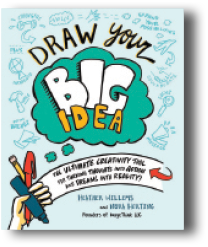 Nora Herting and Heather Willems. 2016. San Francisco, CA: Chronicle Books. [ISBN 978-1-4521-5292-9. 174 pages. US$19.95 (softcover).]
Nora Herting and Heather Willems. 2016. San Francisco, CA: Chronicle Books. [ISBN 978-1-4521-5292-9. 174 pages. US$19.95 (softcover).]
When was the last time you took out a pencil and sketched something? When was the last time you doodled in a meeting? Or, during a lecture?
Draw Your Big Idea: The Ultimate Creativity Tool for Turning Thoughts Into Action and Dreams Into Reality! authors, Nora Herting and Heather Willems, state that “drawing out your ideas leads to a deeper understanding of a problem and faster decision-making” (p. 12). They sold me hands-down on the value of drawing. I tried their drawing exercise, 5 Simple Drawing Elements (p. 16), and didn’t expect to come away with anything more than a simple drawing. I chose to draw the clock on my desk, which our company presented to each employee 15 years ago. I have used my clock daily to check the time. However, as I drew the details of the clock with its Roman numerals, I was shocked to discover the number 4 was actually written as “IIII” on the clock face instead of “IV”! Had I not drawn the details, I would have continued to overlook this. I asked my fellow co-workers, who also received a company clock at the same time as me, and they, too, never noticed the “IIII.”
When I presented my discovery to my manager, she instantly saw the value of drawing. Now, our entire writing team is learning to incorporate drawing not only in everyday sketches, but we’re now developing a library of icons that we can use in our technical documentation and courseware.
Draw Your Big Idea opens with the case for visual thinking and modeling. Herting and Willems then describe the advantages of why you should draw. The book contains 100 drawing exercises for such things as discovering your passion, declaring your purpose, identifying your idea, picturing your customer, sharing your message, and charting your path. These exercises will help you sharpen your vision and brainstorm better.
On a personal level, I particularly liked tracking my day using a pie chart (p. 154), mapping my environment (pp. 98–101), and mapping my network (pp. 102–105). Two exercises, My Customers (pp. 118–119) and A Day in the Life (pp. 120–121), are useful for better understanding customers.
As a writing team, we used the Charting a Path exercise (pp. 168–169) to map out our next project. The path begins by identifying the strengths, skills, and resources to be gathered along the way to reach the big goal. Along the way are set milestones that must be passed. Having a visual where we could log these streamlined our planning, as it enabled our team to keep focused on the big goal.
I encourage you to read Draw Your Big Idea and start sketching. You will discover details in things you have never before noticed. Also, during your next meeting, pick up a pencil and start doodling. You will find yourself absorbing more of what is being presented.
Rhonda Lunemann
Rhonda Lunemann is a technical writer with Siemens PLM Software and is a senior member of STC’s Twin Cities Chapter. She also participates in a local writers’ group, Write Now!.
The Vignelli Canon
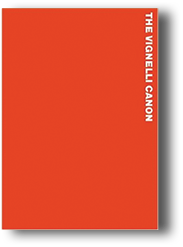 Massimo Vignelli. 2015. Zurich, Switzerland: Lars Muller. [ISBN 978-3-03778-225-5. 110 pages. US$20.00 (softcover).]
Massimo Vignelli. 2015. Zurich, Switzerland: Lars Muller. [ISBN 978-3-03778-225-5. 110 pages. US$20.00 (softcover).]
The Vignelli Canon—written by Massimo Vignelli (1931–2014), one of the ultimate graphic design legends—was completed shortly before his untimely death in 2014. The book offers great insight into this pioneering designer’s methods and approach to modernism in design. It is a fairly short book, yet it is dense in content. While it could probably take about two hours to read it cover-to-cover, it might take longer to digest the information and even require rereading and reflection. I highly recommend this book for students and design educators as well as for professionals seeking inspiration and motivation.
In the introduction, Vignelli states that his basis for creating the book was for it to serve as a “useful instrument for a better understanding of typography in Graphic Design” (p. 4). He claims to have seen a decline in typographic standards and laments that the education of today’s student is lacking in this area. And while the book does an excellent job of sharing and expressing Vignelli’s beliefs and standards of typography, The Vignelli Canon also provides insight into the process, beliefs, and standards from a pioneer of the Modernist movement in America.
The Vignelli Canon is a collection of short essays on the author’s own theories covering design processes and practices. He breaks the book into two parts: The Intangibles and The Tangibles, which are essentially his ideas on design theory and application, respectively. Within The Intangibles section, Vignelli offers his insight on various topics including the value of design history, theory, and criticism as well as discipline, appropriateness, and responsibility. All while The Tangibles side explains his dictums on grids, typefaces, scale, type relationships, and layout. Lastly, the text also contains many gems that reflect Vignelli’s genius, which readers can quote or use for direct inspiration, such as “In a world where everybody screams, silence is noticeable. White space provides the silence. That is the essence of our typography” (p.86) and “Good design is never boring, only bad design is” (p. 69). The Vignelli Canon is quite broad in content and includes information that most people might overlook when creating a design; such as taking into consideration the space that the viewers thumbs encompass when holding a book, and adjusting the margins accordingly in your design.
Despite his claims otherwise, the text is a bit dogmatic in its approach to modernism and its strict formula for good typography. However, most readers will be able to see past Vignelli’s rules and delight in his efforts to share his doctrine with the design community. His continual use of the word “we” within the text is a reminder that the book outlines the Vignelli approach, put forth by Massimo and Leila Vignelli, and is not something in which all designers must adhere. Readers will be able to directly apply the information to their own designs or reflect on how that information influences their own designs.
Amanda Horton
Amanda Horton holds an MFA in Design and currently teaches graduate and undergraduate courses at the University of Central Oklahoma in the areas of design technology, design studio and history of graphic design. She serves as a book reviewer for Technical Communication.
Technique in Nonfiction: The Tools of the Trade
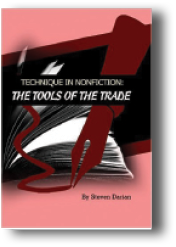 Steven Darian. 2016. Ronkonkoma, NY: Linus Learning. [ISBN 978-1-60797-571-7. 272 pages, including index. US$24.00 (softcover).]
Steven Darian. 2016. Ronkonkoma, NY: Linus Learning. [ISBN 978-1-60797-571-7. 272 pages, including index. US$24.00 (softcover).]
How does a writer tantalize students and non-motivated audiences into reading non-fiction—whether it is served up in textbooks, journal articles, or trade books? Steve Darian, college professor and author of a dozen non-fiction books, recommends employing techniques and strategies used by successful fiction authors.
As professionals, technical communicators will already be familiar with the meaty portions of this book’s ten parts and chapters. Plus, there are scrumptious tidbits hiding within unlikely chapters with Verbs, Nouns, and Adjectives in their titles.
Darian correctly begins Technique in Nonfiction: The Tools of the Trade with the reader. No matter what knowledge we are trying to impart, he says that communication is the attempt to build a relationship. We want to intrigue or inspire without drowning the reader in information. Identifying our audience—primary and any secondary—keeps the message direct and simple while making the writer more approachable.
Communication tips offered: use a signature format for a given field, find something interesting to say, use humor, and appeal to the reader’s senses.
Parts 3 through 5 are as close to grammar as the author gets. In this quick-reference laden with examples, Darian informs us that verbs activate the nervous system which controls movements depicted by the verb. And he suggests ways to use flexible nouns in the role of verb or adjective.
Sentence and paragraph structure along with punctuation pointers may be the writer’s bread and butter, but how many know that there are strong, medium, and weak punctuation choices? Stronger punctuation is typically reserved for presenting a long, complex, or difficult series of items.
Parts 6, 7, and 9 are a bonus for writers new to preparing a trade or textbook for publication. Anyone who reads fiction should know how to use openings and closings to tie up loose ends. But how many technical communicators were ever instructed in handling titles, headings, summaries, citing sources, or navigation tools such as table of contents?
In Part 8, Some Writers’ Techniques, Darian sends us to scout out and adapt rhythm and alliteration from poetry and other writing styles. He also admonishes that we must provide examples so the reader doesn’t have to. Following his own advice, the author illustrates every chapter with multiple examples drawn from periodicals, books, and manuscripts.
Part 10 explains the revision process, a topic again suitable to the novice author. For the pros, Darian excites our taste buds one last time with an explanation of how non-fiction does indeed employ plots. Known as themes, these can pull together all ingredients to create a written feast.
Technique in Nonfiction is geared toward the trade and textbook markets, with a Student book available online. Use of numerous examples is perfect for a textbook—a bit repetitive for the trade market. The table of contents is exhaustive. The index is underwhelming, especially with page numbering off.
Donna Ford
Donna Ford has been an STC member, joining in 1990 and serving on her local chapter’s board for many years. She has been a technical writer since 1987 in the hardware, software, and government healthcare industries. Donna holds a certificate in Information Design from Bentley College. She also reviews books online for the US Review of Books.
Free Agent: The Independent Professional’s Roadmap to Self-Employment Success
 Katy Tynan. 2015. Boca Raton, FL: CRC Press. [ISBN 978-1-4822-5881-3. 162 pages, including index. US$35.95 (softcover).]
Katy Tynan. 2015. Boca Raton, FL: CRC Press. [ISBN 978-1-4822-5881-3. 162 pages, including index. US$35.95 (softcover).]
Free Agent: The Independent Professional’s Roadmap to Self-Employment Success gave me an easy-to-read roadmap for preparing to work for myself. This book provides insight about the changing workplace, the necessities to start freelancing, and strategies for long-term success.
Tynan begins by explaining the evolving business climate. Immediately before the 2008 Great Recession, many companies reduced their full-time workforce. They switched to contractors and continued operating this way after the economy improved.
The second section conversationally outlines how to successfully start freelancing. “[T]he very best thing you can do for yourself is to spend some time developing a clear and specific understanding of how you create unique value for your customers” (p. 108). Tynan addresses transitioning from employee to self-employed and figuring out your cash flow. She says the first things you need are a name, structure, and bank account. She encourages budgeting for a lawyer, accountant, and insurance agent. Use their expertise to verify that you are meeting IRS guidelines and are prepared for unexpected problems. Understanding these operating costs will help you calculate your rate. Tynan recommends building a cushion into that rate for unexpected expenses and slowdowns.
In regard to finding customers, Tynan advises that you mine your current contacts, including previous employers. She stresses the importance of networking: Rather than trying to meet everyone at a networking event, look for two people that you genuinely like. Then, figure out how to help their business—even if it does not generate any immediate business for you, which helps to build a solid network that will support future growth. When you find a potential client, consider a thorough evaluation of their needs, then address those needs in your pitch. Create a statement of work that outlines exactly what you will do for what price to protect yourself from scope creep. If the customer asks for more work, you have a basis to start discussing what has to fall off the deliverable list or how much more time and money the additional requirement will cost.
Tynan focuses the last section on avoiding burnout and growing your business. She advises that free agents build “a balanced life so that you don’t feel like a slave to your clients” (p. 95) and connect with other independent professionals to partake in the social interactions many freelancers forgo.
Tynan’s book outlines a great starting point for freelancers to prepare their business plans and begin budgeting their expenses. She encourages freelancers to network with other freelancers and invest in training. Free Agent checks some of those boxes—it’s not in-person networking, but it can give you some insight from someone who has tackled similar challenges. The real value in this book came in her detailed roadmap for starting a business that included stellar explanations about planning for taxes, establishing client expectations, and defining your goals for an independent career.
Stephanie Saylor
Stephanie Saylor is an STC member and a technical writer at Next Century Corporation. She received her master’s degree in digital communication from Johns Hopkins University. Stephanie is a plain language enthusiast, working mom, advocate for food allergy awareness, and tweets @plainlang.
Technical and Professional Communication: Integrating Text and Visuals
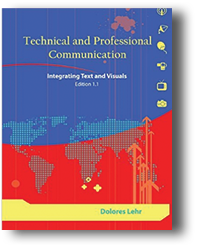 Dolores Lehr. 2015. Edition 1.1. Indianapolis, Indiana: Hackett Publishing Company. [ISBN 978-1-58510-793-3. 212 pages, including index. US$36.95 (softcover).]
Dolores Lehr. 2015. Edition 1.1. Indianapolis, Indiana: Hackett Publishing Company. [ISBN 978-1-58510-793-3. 212 pages, including index. US$36.95 (softcover).]
Technical and Professional Communication: Integrating Text and Visuals is a college textbook designed to introduce written communication skills to aspiring writers. While you may consider yourself well past your college years, every technical communicator will find something of value in this book. Any technical writer can learn something from Technical and Professional Communication, whether it is learning new ways to format your résumés, to giving oral presentations, to brushing up on grammar.
Lehr uses her book as a model for the ideas she is promoting. For example, key concepts to effective communication are organization and presentation, which this book exemplifies. It is broken into thematic sections, such as “Integrating Text and Graphics” with each section containing several chapters. The chapters cover specific topics, such as “Reports,” “Using Tables, Color, and Figures,” and “Common Grammatical Errors.” Each chapter consistently uses tiered headings to break the content into easily digested pieces. Unsurprisingly, throughout the book effective illustrations demonstrate ways to best implement illustrations in various types of documentation. Concluding each chapter are a checklist and a set of exercises. The checklist helps you determine if you have grasped the primary concepts described in the chapter, such as “do you know how to label appendixes?” The exercises are more in-depth, such as asking you to list the advantages and disadvantages of including an objective on your résumé. At the end are a few appendixes that serve as useful references for all writers. For example, if you can never remember whether to write “8” or “eight,” the appendixes will guide you. Reading through the book is smooth and easy but also thought-provoking at times when you stop to consider certain concepts.
Overall, Technical and Professional Communication provides a great overview of the technical communication basics. The book follows its own advice for structure, layout, and design. Each section contains multiple visual examples so you can easily look up how to compose correspondence ranging from an email to sample résumé. It can also serve as a reference guide for common editing questions, such as rules for punctuation or how to use different citation styles. I recommend this book to anyone looking to learn technical communication and to anyone who is already in the field and looking to refresh or update their skills.
Timothy Esposito
Timothy Esposito is an STC Associate Fellow with over 15 years of technical communication experience. He is currently president of the STC Philadelphia Metro Chapter. Before becoming president, Timothy was chapter vice president, treasurer, webmaster, and scholarship manager.
The ABCs of How We Learn: 26 Scientifically Proven Approaches, How They Work, and When to Use Them
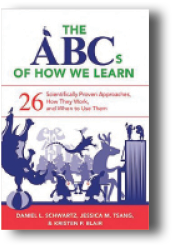 Daniel L. Schwartz, Jessica M. Tsang, and Kristen P. Blair. 2016. New York, NY. W.W. Norton & Company. [ISBN 978-0-393-70926-1. 368 pages, including index. US$24.95 (softcover).]
Daniel L. Schwartz, Jessica M. Tsang, and Kristen P. Blair. 2016. New York, NY. W.W. Norton & Company. [ISBN 978-0-393-70926-1. 368 pages, including index. US$24.95 (softcover).]
Overall, The ABCs of How We Learn: 26 Scientifically Proven Approaches, How They Work, and When to Use Them is an excellent text that is useful as both a reference text for working educators frustrated with teaching problems and an introduction for new educators to 26 teaching tools, methods, and concepts. Chapters are organized in a consistent manner with each chapter running not more than 12 pages. Enhanced by the accessible writing style and pragmatic goal, “The purpose of this book is to help people understand learning and to creatively develop methods of instruction suited to their learning goals, whether for themselves or another” (p. xiv), this makes for a book with useful chapters. Each chapter ends with a one-page summary that reminds readers about key concepts or helps potential readers. Of interest to graduate students or faculty: Each chapter also has a short list of referenced works.
The book’s cover is gimmicky and weak, and it makes the book appear self-published and poorly designed. After reading the book, it’s clear that each animal on the cover matches with one of the 26 letters of the alphabet. Before reviewing the book, the animals’ relevance is not clear. This is unfortunate and surprising, especially since all three authors work and teach at the Stanford University Graduate School of Education, and the book has praise from a Nobel Laureate who also works at Stanford. The cover neither conveys nor indicates the levels of experience or skill the authors bring to the text. The cover also fails to affirm the high caliber content it advertises.
Besides consistently solid chapters, The ABCs of How We Learn is well-organized. The Problem-Focused Index on pages 349–350 presents alphabetically organized problems that teachers may likely face and then the appropriate chapters are indicated to the right. This Index, while useful, should have appeared at the front of book so that readers considering the book and seeking solutions could find what they need. The volume was useful in providing specific, trouble-shooting approaches for challenges I face in my online classrooms. While the book appears grounded in face-to-face teaching, it is useful for both face-to-face and online educators.
One perk: When most chapters review a concept, they ask “Can people learn to teach themselves with Concept X.” A second perk is that this text lends itself to be a source for education teachers or instructional designers seeking specific chapters, or chapter summaries, to share key concepts with students, colleagues, or new faculty in training.
Worth the money, but the book needs a new cover.
Gregory Zobel
Gregory Zobel is an assistant professor of Educational Technology at Western Oregon University.
The Elements of Blogging: Expanding the Conversation of Journalism
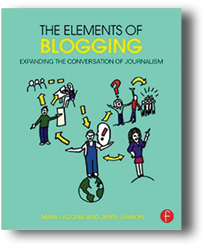 Mark Leccese and Jerry Lanson. 2016. Focal Press. [ISBN: 978-1-138-02154-9. 270 pages, including index. US$34.95 (softcover).]
Mark Leccese and Jerry Lanson. 2016. Focal Press. [ISBN: 978-1-138-02154-9. 270 pages, including index. US$34.95 (softcover).]
Each with a background in blogging and teaching journalism, authors Mark Leccese and Jerry Lanson give a big picture look at blogging in the context of traditional writing and journalism. The Elements of Blogging: Expanding the Conversation of Journalism could be helpful to someone starting out in blogging or for a teacher looking for a good textbook. The approach is, in general, scholarly and thoughtful.
Examples appear throughout The Elements of Blogging to show how the authors grew their following, and a little appears about how to monetize and/or grow revenue for a blog. The focus is on how to find a voice, write an effective headline, build an argument, and find a niche and audience. Exercises and discussion questions also appear in each chapter.
Doing a good job of explaining that blogs primarily either report information or give opinions, the authors cover topics such as news, op-ed pieces, politics, art, food, and travel. As an example of how the authors approach their topic, they write that “many serious bloggers do independent reporting, consult and link to primary sources, verify facts, and maintain high ethical standards, just as professional journalists do” (p. 21). The Huffington Post is an example of such serious blogging.
Other examples that appear throughout give an in-depth look at success. Talia Ralph has a success story as she notes, “Blogs work best when readers are responding not just to the topic, but to the person writing” (p. 71) and explains about her postings as they reflect her interest in food studies and how she “lives in the world of food blogging” (p. 72).
The http://www.theelementsofblogging.com site is worth a visit as it gives you an idea of the authors’ interests and style. It covers topics such as academia, arts, headlines, interviewing, literature, media, news, politics, reviewing, and travel. For example, one posting is about why those in academia should blog. You get a wider audience. It’s quick. It provides an informal format for discussion. This leads me to ask if and how we in our communities would benefit from this media and communication form.
Jeanette Evans
Jeanette Evans is an STC Associate Fellow and active in the NEO community, currently serving on the newsletter committee. She holds an MS in technical communication management from Mercer University and most recently published an article, “Emerging Technologies: Where We Have Been and Where We Are Going” in STC’s Intercom magazine.
Human Computer Interface Technologies for the Motor Impaired
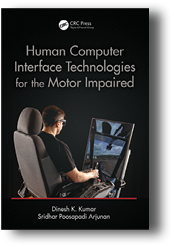 Dinesh K. Kumar and Sridhar Poosapadi Arjunan. 2016. Boca Raton, FL: CRC Press. [ISBN: 978-1-4822-6266-7. 186 pages, including index. US$89.95.]
Dinesh K. Kumar and Sridhar Poosapadi Arjunan. 2016. Boca Raton, FL: CRC Press. [ISBN: 978-1-4822-6266-7. 186 pages, including index. US$89.95.]
 Human-Computer Interface Technologies for the Motor Impaired focuses on establishing an important dialogue among scientists and engineers, clinicians, caretakers, and customers about the existing technologies for the disabled. This book contains 10 chapters that catalogue and discuss in great detail human-computer interfaces (HCIs) available for people with injuries, diseases, and weaknesses due to aging. Kumar and Arjunan state that their purpose in writing this book is to help provide a platform for stakeholders to interact and improve on the technologies.
Human-Computer Interface Technologies for the Motor Impaired focuses on establishing an important dialogue among scientists and engineers, clinicians, caretakers, and customers about the existing technologies for the disabled. This book contains 10 chapters that catalogue and discuss in great detail human-computer interfaces (HCIs) available for people with injuries, diseases, and weaknesses due to aging. Kumar and Arjunan state that their purpose in writing this book is to help provide a platform for stakeholders to interact and improve on the technologies.
The authors synthesize their painstaking research around the interface devices based on currently available modalities, such as video, speech, mechanical, electrooculogram, and brain waves, etc. Their clear, concise, and accessible writing style provides a helpful overview of the history, variations in each type of technology on the market, and projected direction in research and enhancement of the devices.
In addition, Kumar and Arjunan’s sensitivity and consideration for users manifest itself in a careful analysis of possible benefits, limitations, ease of usage, and certain moral issues attached to particular devices. They hope that bringing together these crucial points of user experience will help strengthen the dialogue about the various technologies—between customers and their caretakers on one hand and researchers, engineers, and clinicians on the other. Moreover, the book’s information enables users to become better educated about the devices they would like to try out without being biased by sales pitches from commercial organizations.
One advantage of a book that encompasses such a varied readers’ audience is its greater inclusiveness compared to books on similar topics—books that usually exclude laymen lacking technical expertise. In fact, all are invited to the table to explore a book with highly technical but comprehensibly written information and more descriptive parts dealing with consequences of the user experiences. Visuals, charts, diagrams, tables, detail-focused references at the end of each chapter, and the book’s glossary— all support readers of different backgrounds through their search for new terms and resources. Thus, the book allows specialists and non-specialists a glimpse into each other’s world, to find better ways of connecting and understanding each other, and working together for their mutual benefit.
Kumar and Arjunan also emphasize the importance of bringing into the discussion another significant and often overlooked audience: the computer games and machine console industries. They might be interested in assimilating HCI technologies for their customers and in such a way to help improve the HCI user experience for the disabled. These industries have a considerable customer base worldwide that could prove a vital source of funding and innovation in HCI research.
Overall, Human-Computer Interface Technologies for the Motor Impaired’s holistic approach to audience inclusion, its design, and clear language all serve as a fine model for discussing an important issue containing complex technical and social features.
Tetyana Darian
Tetyana Darian is an STC member and graduate student in Mathematical Computer Science. Her interests are in scientific computing, cybersecurity, and artificial intelligence.
Scientific and Technical Translation
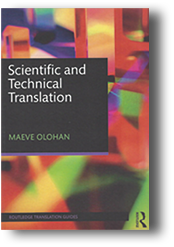 Maeve Olohan. 2016. New York, NY: Routledge. [ISBN 978-0-415-83786-6. 254 pages, including index. US$39.95 (softcover).]
Maeve Olohan. 2016. New York, NY: Routledge. [ISBN 978-0-415-83786-6. 254 pages, including index. US$39.95 (softcover).]
Scientific and Technical Translation is one of those books I wish I had when I was a student at the Centre for Translation Studies in Vienna at the beginning of the 1990s. The book would have definitely prepared me for the job I got after graduating: I left Austria and came to Ireland to work as a technical translator in the software localization industry, learning on the job about tools such as Translation Memories and the specific situations in which technical specialists communicate. All this can be found in Olohan’s comprehensive coursebook, which can be used for any higher-education program where technical or scientific translation is taught, because, as she says, “It assumes no prior specialized translation experience” (p. 3).
The coursebook is part of the Routledge Translation Guides and specifically focuses on texts that are typically translated in scientific and technical domains. Five chapters are dedicated to different industry areas: Technical instructions (Chapter 3), Technical data sheets and technical brochures (Chapter 4) in the field of technical documentation; Patents (Chapter 5), and Scientific research articles and abstracts (Chapter 6) in the field of communication of scientific knowledge. Each chapter contains a sound introduction, typical examples, exercises, and key points, ending with numerous references.
What gives Scientific and Technical Translation extra value are its first two rich, informative chapters. Chapter 1 (Scientific and technical translation as a professional activity) outlines some of the typical workplace configurations for translators and other professionals in the sector and presents the translation brief and the translation project specification as helpful tools. As a former in-house translator employed by a translation company who turned into a technical writer more than 15 years ago, I could truly see myself in the translation landscape that Olohan describes in this chapter.
Equally important and helpful for any would-be technical or scientific translator is Chapter 2 (Resources for scientific and technical translation), where you find a concise but valuable overview of corpus-based terminology research as well as translation memory (TM), machine translation (MT) technology, and tools.
A crisp glossary and a wealthy appendix with all examples complete this coursebook. As Olohan writes, the book’s purpose is not to reduce translation to a set of prescriptions or formulae. “Rather, it focuses on familiarizing you with texts that are typically translated in scientific and technical domains.…However, you will also be guided in your decision making by what you know or assume about the expectations and needs of your translation commissioner and the end users of the text” (p. 4).
What I like most about Scientific and Technical Translation is the abundance of real-life examples (which made me think more than once: “Yes, that’s exactly how it really is!”), a wealth of information that will really help you take off in the translation world as well as the readable and practicable way Olohan presents the information .
Karina Lehrner-Mayer
Karina Lehrner-Mayer holds a degree in translation and has over 15 years’ experience in Technical Communication in Ireland and Austria. She works as a Technical Writer at ISIS Papyrus Europe AG, an Austrian-based company offering solutions for inbound and outbound business communications, where she is responsible for the Documentation Style Guide.
Start Differently: How to Inspire Your People, Turn Conflicts into Cooperation and Run Successful Projects
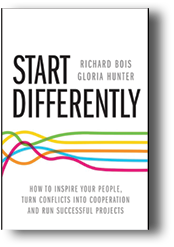 Richard Bois and Gloria Hunter. 2015. San Bernardino, CA: Rethink Press. [ISBN 978-1-78133-152-1. 130 pages. US$16.99 (softcover).]
Richard Bois and Gloria Hunter. 2015. San Bernardino, CA: Rethink Press. [ISBN 978-1-78133-152-1. 130 pages. US$16.99 (softcover).]
Richard Bois and Gloria Hunter’s Start Differently: How to Inspire Your People, Turn Conflicts into Cooperation and Run Successful Projects is the type of book often on sale at workshops and seminars. In such a book, the presentation highlights appear, but it omits the more specific material found in the question-and-answer and discussion sessions.
Bois and Hunter claim that trouble occurs in team-solving problems that teams face because they start with objectives rather than agreeing on the problem. One of their examples is of a company doing business in China that realizes that their profits and market share are dropping. The usual approach is to start with an objective: “To increase profits and market share.” The approach is inadequate because the teams usually do not necessarily agree on why profits are down and market share is dropping. Rather, the authors suggest that the team take time to define the problem more specifically.
The Richard Bois Concept then addresses the methods used to gather the requisite data. The sections address developing information effectively, conducting interviews and workshops, and selling the proposal to solve the problem.
The Concept involves five steps: defining the problem statement, analyzing the situation, defining the objective, defining strategies and actions, and implementing the solution and tracking it. Each step consists of sub-steps; for example, when defining the problem, the authors suggest wording it as a statement and not a question. Once defined, the second part is to define the stakeholders. The third section of problem-solving is to narrow the scope. Each step ends with an example, a case study, applications, and an exercise.
The remaining sections follow this pattern; once the authors explain the Richard Bois Concept, they discuss specific tools: reviewing the previous process, interviews, workshops, and proposals. A case study presentation and extended exercise complete the book.
One problem I have with Start Differently is that it is set in (what looks like) 12 point sans serif type with extra leading. That suggests that the book could be shorter if more traditional type size and leading were used. As it is, the book does suggest seriousness to the message that may not be there. Another problem is that the Concept seems to assume that you can apply this method to any problem. The amount of time needed for this approach suggests large, complex problem-solving situations. Like any such self-help book (and, I assume, seminar), all will be well and run smoothly if you apply their method—here start by defining the problem not an objective. Granted, the Richard Bois Concept does cut the preliminaries so that the team can address analysis and proposed solutions sooner.
For someone new to team leadership, Start Differently can be a good way to start, and it is a fast read because of the large type and increased leading.
Tom Warren
Tom Warren is an STC Fellow, Jay R. Gould Award for Excellence recipient, and professor emeritus of English (technical writing) at Oklahoma State University, where he established the BA, MA, and PhD technical writing programs. Past president of INTECOM, he served as guest professor at the University of Paderborn, Germany.
Teaching Communication and Media Studies: Pedagogy and Practice
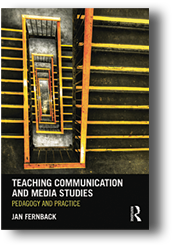 Jan Fernback. 2015. New York, NY: Routledge. [ISBN 978-0-415-88664-2. 174 pages, including index. US$42.95 (softcover).]
Jan Fernback. 2015. New York, NY: Routledge. [ISBN 978-0-415-88664-2. 174 pages, including index. US$42.95 (softcover).]
Communication is a culture practice for creating, maintaining, and transmuting society. Studying “how we live in the world” that acknowledges our media-inundated existence is significant for holistic personal development and citizenship promotion. Jan Fernback in her book, Teaching Communication and Media Studies: Pedagogy and Practice, provides a conceptual and practical guide to mediated communication pedagogies. These pedagogical strategies are both unique to mediated communication and broad to cover all aspects of college teaching.
In the introduction, Fernback views Sprague’s (1993) discipline-specific pedagogy as the fundamental approach to this book. The discipline-specific pedagogy recognizes the implicated cultural identity in communication process, form, and content. Fernback argues that teaching is not a by-product but a focus of research. A teacher’s academic identity is, as a result, the combination of researcher and teacher. In chapters 2–8, Fernback discusses the teaching philosophy, technologies in the classroom, learning objectives, course goals and assessment, instructional design, learning patterns, and ethics and citizenship in teaching communication.
Teaching philosophy systematically represents a teacher’s academic identity and serves as the birthplace for teaching practices. Inherited John Dewey’s (1916) philosophy that society exists in communication, Fernback advocates active learning to encourage students’ engagement, and through that engagement to create actual experience and to understand their roles as media creators and consumers. Active learning can enhance the students’ social consciousness and finally contribute to social reconstruction.
Knowing categories of thinking and ways of learning is imperative before setting course goals, assessing learning, and structuring courses. Chapter 4 illustrates the hierarchies of thinking and the skill, affective, and cognitive dimensions in learning strategies. Fernback designs an overlay of cognitive objectives and five levels of affective goals for media and communication studies based on Bloom’s (1954) taxonomy besides the psychomotor competencies based on Simpson’s (1972) skill dimensions. Chapter 7 discusses Kolb’s experiential learning theory and “learning styles inventory,” both of which originate from Dewey’s (1938) argument of learning from experience.
Chapters 5 and 6 address the process of goal setting, assessment, and course construction. The characteristic of these chapters (and throughout this book) is the interviews of experienced instructors who offered concrete teaching practices on various issues: for example, what is the process of setting course goals, how these goals reflect the teaching philosophy, how to construct assessment, course design dictated by course goals, etc. These interviews and sample exercises are valuable first-hand experiences to new teachers.
Teaching Communication and Media Studies also features teaching with new technologies and in a digital environment. Fernback warns teachers not to dazzle students with technology because it does not mask teaching inadequacies. Instead, educators should deploy proper technologies guided by teaching philosophy and course goals. For teaching in a digital culture, Fernback introduces the connectivism theory that accounts for collaborative learning and digital literacy. She also designs approaches for online courses.
I recommend this book to those who teach communication/media studies or related disciplines for systematic course design to enhance their teaching experience and open discussions of emerging teaching issues in a digital environment.
Lin Dong
Lin Dong is a PhD candidate in Rhetoric and Composition at Georgia State University. She is currently preparing her dissertation on international crisis communication from a sociotechnical aspect. Lin has broad research interests in transcultural and international rhetoric and communication, especially in technical and professional communication in global contexts.
The Master Communicator’s Handbook
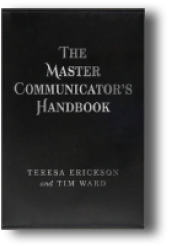 Theresa Erickson and Tim Ward. 2015. Alresford, Hant, United Kingdom: Changemakers Books. [ISBN 978-1-78535-153-2. 84 pages. US$14.95 (softcover).]
Theresa Erickson and Tim Ward. 2015. Alresford, Hant, United Kingdom: Changemakers Books. [ISBN 978-1-78535-153-2. 84 pages. US$14.95 (softcover).]
The Master Communicator’s Handbook was written by a “Master Communicator” and is for those who wish to become one. It is one of the few books out there that is concerned not only with getting your message across to your readers and listeners but also with having them act on it. As the authors state, “Communication is not about output [by the writer], it’s about impact [on the reader]” (p. 21).
This book is not Communications 101. It isn’t concerned with K.I.S.S. (Keep It Simple Silly), readability formulas, or Joe Williams’ elegance. It is not about grammar. Plenty of books exist today for that. The Master Communicator’s Handbook is about how to write to your readers and listeners so that they don’t hit the Delete button before they get to the second paragraph or turn to their phones while you are speaking. It’s written so that you become a “powerful advocate for your cause and your organization . . . a catalyst for transformation” (p. 3). As the authors state in their introduction, their “approach to communications is based on clarity, leadership and impact” (p. 2).
The Master Communicator’s Handbook is specifically written for those in organizations “dedicated to making the world a better place,” such as the World Wildlife Fund (WWF), the Society of Conservation Biology, the United Nations, the World Health Organization (WHO), and the World Bank, all clients of the two authors. The authors sprinkle in actual stories of their clients’ communication challenges and their solutions.
I began examining this book thinking I would simply skim it, yet by Chapter 2, I was reading slowly and underlining and annotating new ideas, underlying concepts, and tips.
It is a book that recognizes and stresses the need to write reader–based documents. That need has taken the authors, just as it has this reviewer, to study neuroscience to understand how we read, why we act, and what makes us act the way we do, and then apply these theories to our communications.
Several chapters are specifically concerned with oral communication, speaking to both large and small groups. These include aspects that are seldom discussed, including answering questions and using symbols and icons. Most chapters, however, contain recommendations that are applicable to both oral and written communication. These, too, contain topics that are almost never covered in books on effective communication, including framing an argument, what the psychologists term cognitive cultural dissonance, transformational storytelling, and reframing (changing people’s positions on a topic}.
Anyone working in a nonprofit or environmental organization can find much needed assistance for “changing the world” in The Master Communicator’s Handbook. I certainly did.
Carolyn Boiarsky
Carolyn Boiarsky, PhD, is an STC Associate Fellow and a 1998 winner of the Frank R. Smith Award. She teaches in the English Department at Purdue University Northwest-Calumet Campus. Carolyn is the author of three books related to technical communication, the most recent being “Risk Communication and Miscommunication” (2016).
Academy-Industry Relationships and Partnerships: Perspectives for Technical Communicators
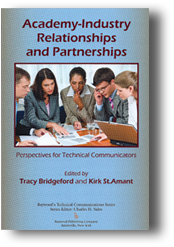 Tracy Bridgeford and Kirk St.Amant, eds. 2015. Amityville, NY: Baywood. [ISBN 978-0-89503-907-1. 256 pages, including index. US$75.00 (softcover).]
Tracy Bridgeford and Kirk St.Amant, eds. 2015. Amityville, NY: Baywood. [ISBN 978-0-89503-907-1. 256 pages, including index. US$75.00 (softcover).]
Academy-Industry Relationships and Partnerships: Perspectives for Technical Communicators is an edited collection that delves into a relevant trend within technical communication: the relationship between academic researchers and industry-based practitioners. As Carolyn Rude mentions in the book’s Foreword: “It is hard for academics to know the needs of the field and to develop research and curricula appropriate to practice if we do not talk with people in industry” (p. vi–vii). And as St.Amant writes in his introduction: “[T]he goal of this collection is to provide a sampling of approaches readers can use when considering how they, as members of academia or industry, might approach this idea of collaborating within different context” (p. 3). The book’s goal is to help both academics and industry practitioners of technical communication help each other to grow the field.
The editors explore this reciprocal relationship through 11 chapters on topics ranging from perspectives on technical communication programs in universities to reflections on relationships with various industry contexts to venues for fostering relationships to mutually beneficial opportunities for research and writing. Each chapter is written by different author(s) and covers the following approaches to fostering academy–industry relationships: using stakeholder theory (Chapter 1), entrepreneurship (Chapter 2), experiential learning (Chapter 3), internships (Chapter 4), mentoring programs (Chapter 5), partnering with government (Chapter 6), partnering via emerging technologies (Chapter 7), partnering via a user experience facility (Chapter 8), engaging with community-based organizations (Chapter 9), developing mutually beneficial research agendas (Chapter 10), and using virtual collaboration (Chapter 11).
As an academic, I found all these approaches to be exciting methods for engaging with my industry counterparts. Each chapter provides clear, hands-on advice for trying out the approach discussed. Tharon Howard’s chapter on fostering partnerships in a user experience (UX) facility, for example, contains very useful reflections on his work as director of the Clemson University Usability Testing Facility. He describes how his role as a UX researcher in academia has changed over the years from providing basic usability testing and documentation services to working more directly with project managers to validate and contextualize digital products and services. I found this reflection to be incredibly useful as an early career academic looking to form these kinds of relationships at my own university.
Though Academy-Industry Relationships and Partnerships would certainly be of interest to members of the industry seeking to form relationships with their academic counterparts, and includes contributions by two respected industry practitioners: Beth L. Hewett and Charlotte Robidoux, I yearned for more work by members of industry. I am curious, for example, what other approaches industry practitioners take when partnering with academics (besides the two discussed here). On the other hand, in my personal experience these partnerships are often driven by academics seeking to develop new opportunities for their institutions, so perhaps this focus is more appropriate than at first glance. Ultimately, the book is a useful and much-needed contribution for anyone looking to foster mutually beneficial relationships between industry and academia to help grow the field of technical communication.
Guiseppe Getto
Guiseppe Getto is a faculty member at East Carolina University. He is also President and Co-Founder of Content Garden, Inc., a digital marketing and UX consulting firm.
The Routledge Handbook of Strategic Communication
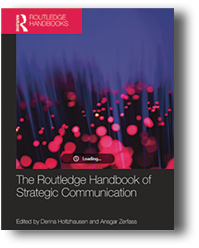 Derina Holtzhausen and Ansgar Zerfass, eds. 2015. New York, NY: Routledge. [ISBN 978-0-415-53001-9. 596 pages, including index. US$219.00.]
Derina Holtzhausen and Ansgar Zerfass, eds. 2015. New York, NY: Routledge. [ISBN 978-0-415-53001-9. 596 pages, including index. US$219.00.]
 For a graduate student in rhetoric and composition, strategic communication has been one of my research interests because it is a much contested, neglected, yet emerging field with exciting opportunities and challenges. It is not easy to find comprehensive literature on the evolutions of concepts and theories since the strategic communication field is witnessing recent development and growth. The Routledge Handbook of Strategic Communication provides the field’s first comprehensive review of research in strategic communication and also presents a compilation of various approaches on dynamic aspects.
For a graduate student in rhetoric and composition, strategic communication has been one of my research interests because it is a much contested, neglected, yet emerging field with exciting opportunities and challenges. It is not easy to find comprehensive literature on the evolutions of concepts and theories since the strategic communication field is witnessing recent development and growth. The Routledge Handbook of Strategic Communication provides the field’s first comprehensive review of research in strategic communication and also presents a compilation of various approaches on dynamic aspects.
This handbook has four parts starting with eight theoretical chapters reviewing the field’s conceptual foundations, followed by eight chapters examining the impact of institutional variables on strategic communication, another six chapters on implementing strategic communication, and ending with fifteen chapters illustrating different research areas of practice. Chapter 1 by Holtzhausen and Zerfass expands the original meaning of strategic communication defined by Holtzhausen et al. to include a “communication sphere” (a more participative public sphere) as an integral construction. Chapters 2 and 3 deconstruct the term of strategy and identify an emerging “strategic turn” that transforms all communication into strategical communication. Chapters 4 and 5 review the philosophical foundation of the public sphere in Europe and in America. Part I concludes with three chapters investigating the application of social theories, like social network theory, to strategic communication.
Part II (Chapters 9–16) provides an institutional perspective on strategic communication issues by analyzing some influential factors to institutional strategizing, such as institutional structure, organizational culture and knowledge, the communication capability of executives, and organizational goals.
Focusing on the interaction between the strategic communicator and stakeholders, Part III presents key concepts and synthesizing theories for strategic message design. Chapter 17 identifies the kinds of strategic communication messages, describes message strategy use and effectiveness, and synthesizes theories from both public relations and advertising into a parsimonious framework for strategic message design. Chapter 18 shows two experimental studies to test two framing hypotheses, attribute-goal framing, and individual-societal framing, providing a guideline for developing effective messages. Chapters 19 and 20 discuss strategic visual communication. Chapters 21 and 22 argue for participative practice in strategic communication under the impact of new communication technologies.
The 15 chapters in Part IV each deal with a different area of strategic communication, including advertising, terrorism, governmental and political communication, health communication, international non-governmental organizational communication, crisis and risk communication, communication in social change, and the impact of social media to strategic communication.
In summary, The Routledge Handbook of Strategic Communication explores the burgeoning field of strategic communication from a multi-disciplinary perspective. The wide range of topics that the editors cover in this book will help scholars build a comprehensive body of knowledge on both research and practice, and will also direct the promising path for future studies. After close reading, I heartily recommend it as an essential resource book for scholars and graduate-level students interested in strategic communication.
Lin Dong
Lin Dong is a PhD candidate in Rhetoric and Composition at Georgia State University. She is currently preparing her dissertation on international crisis communication from a sociotechnical aspect. Lin has broad research interests in transcultural and international rhetoric and communication, especially in technical and professional communication in global contexts.
Design for the Mind: Seven Psychological Principles of Persuasive Design
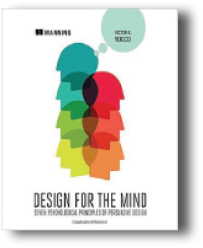 Victor S. Yocco. 2016. Shelter Island, NY: Manning Publications Co. [ISBN 978-1-61729-295-8. 225 pages. US$39.99 (softcover).]
Victor S. Yocco. 2016. Shelter Island, NY: Manning Publications Co. [ISBN 978-1-61729-295-8. 225 pages. US$39.99 (softcover).]
What if you could attract users to your website or application and increase its use and usability by understanding why people behave the way they do? Too often, designers overlook the psychology behind human behavior when creating digital content. In Design for the Mind: Seven Psychological Principles of Persuasive Design, Victor S. Yocco teaches us how to incorporate accepted psychological principles in our digital designs.
This book is divided into four parts. Part 1 introduces readers to the application of psychology to design and the principles of persuasive design. Yocco explains why he chose these principles and the criteria he used for selecting them, which include extensive research and broad acceptance in academia.
Part 2 discusses Yocco’s first three principles: planned behavior, which is the behavior that individuals knowingly engage in; Prospect Theory and heuristics, which concern making risky decisions and the mental shortcuts people use in their decision-making processes; and Fogg’s behavior model, which introduces the principle of motivation, ability, and trigger.
Part 3 explores the principles of influence and the processes and tactics, which can influence people to change their attitudes. Yocco examines methods of framing communication to influence people, or, in his words, “It’s not what you say; it’s how you say it!” (p. 141). He puts a positive spin on the concept of persuasion, which focuses on generating a new or reinforced attitude toward a product and its use.
Each chapter in Parts 2 and 3 includes several features: a scenario of the principle in action, its academic background and research history, real-life digital design examples, a case study, a summary of key points, and a user exercise. Yocco also presents what he calls “talking the talk,” in which he provides the rationale and sample narrative that can be used when pitching your design to clients. Yocco provides a detailed list of references at the end of each chapter for those readers who want to delve deeper into the science behind his principles.
Part 4, “Putting it All Together,” applies the seven psychological principles in an in-depth case study. This part also provides a roadmap for designers to begin using psychological principles in their own designs and provides techniques for measuring the effectiveness of their design improvements after applying these principles.
Yocco presents the information in Design for the Mind in a well-organized, clear, and consistent manner. He provides myriad examples of websites that are directly applicable to Yocco’s principles. He directs us through the design process, from determining what psychological principles best apply to our design to measuring our return on investment after incorporating these principles. Yocco has created a valuable guide for anyone involved in the design of an effective website or application.
Alice Gero
Alice Gero is pursuing her master’s in Technical Communication at the University of Alabama in Huntsville. She currently works at SAIC as a technical writer supporting a major US Army Aviation project.
Herbert Leupin: Poster Collection 28
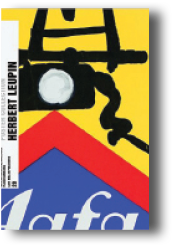 Bettina Richter, Hermann Strittmatter, and Museum für Gestaltung Zürich, eds. 2016. Zürich, Switzerland: Lars Müller Publishers. [ISBN 978-3-03778-506-5, 80 pages. US$25.00 (softcover).]
Bettina Richter, Hermann Strittmatter, and Museum für Gestaltung Zürich, eds. 2016. Zürich, Switzerland: Lars Müller Publishers. [ISBN 978-3-03778-506-5, 80 pages. US$25.00 (softcover).]
 Herbert Leupin: Poster Collection 28 showcases the unparalleled conceptual image-making of Leupin’s oeuvre through the medium of the poster. This new publication traces work produced over his long career beginning in 1939 and progressing to his iconic cartoonish style and playful approach to advertising goods. Richter says, “Leupin’s posters get their message across with charm and wit. They tell their audience stories without saying a word and lure customers with easy-to-solve Rebus puzzles” (p. 5).
Herbert Leupin: Poster Collection 28 showcases the unparalleled conceptual image-making of Leupin’s oeuvre through the medium of the poster. This new publication traces work produced over his long career beginning in 1939 and progressing to his iconic cartoonish style and playful approach to advertising goods. Richter says, “Leupin’s posters get their message across with charm and wit. They tell their audience stories without saying a word and lure customers with easy-to-solve Rebus puzzles” (p. 5).
This book is filled with memorable images reflecting an early conventional Swiss style to a hyperrealistic technique and evolving forms of expression combining photographic material, bright colors, and a playful wit. As Strittmatter says, “The ads have to grab attention, but they should also be extremely entertaining. In other words, advertising has to take people by surprise and be funny and upbeat, evoking a congenial wink of the eye, spreading high spirits and giving the viewer a chance to feel clever for grasping the creative idea behind it” (p. 35). This is the by-product of a renowned Swiss poster designer who embodied a unique perspective and singular vision to tell a brand’s story. The evenly balanced weight of images on the interior pages, showcasing posters across a wide range of cultural institutions, social and civic organizations to commercial projects over five decades, reflects a simple, sophisticated appearance throughout.
The Museum für Gestaltung – Schaudepot’s poster collection is an all-inclusive and remarkable archive of the history of the poster, in Switzerland and throughout the world, beginning in the 19th century to the contemporary era. Richter says, “It was always the idea to find a way to show the treasures of our collection with about 350,000 posters arranging them by themes, graphic designers and so on and to illustrate not only graphic design questions but also looking at posters as a part of a cultural and historical heritage. The focus is on the images, therefore we tried to find a layout which give us in a pattern easily to copy for every new book a possibility to show large images and groups of posters” (private email conversation).
Altogether, Herbert Leupin: Poster Collection 28 is an engaging, comprehensive historical analysis, supplemented by a numerous collection of Leupin’s stylistically diverse repertoire of poster designs. As a foremost proponent of the Sachplakat or “Object Poster” style of the 1940s, Leupin developed a realistic style of poster art to convey simplified messages by reducing words and images to a shorter form to communicate straightforward information. The book is essential reading for design students interested in the art of Swiss advertising and poster design as well as necessary reading for the specialized professional, or anyone interested in 20th century graphic design history. It is a key addition to the evolution of graphic design history as a scholarly discipline and a very useful resource on Swiss advertising graphics and modern graphic design.
Richard Doubleday
Richard B. Doubleday is an Associate Professor in the Department of Graphic Design at Louisiana State University’s School of Art. He is a contributing author for Dialectic: a scholarly journal of thought leadership, education, and practice in the discipline of visual communication design; Phaidon Archive of Graphic Design; and Meggs’ History of Graphic Design.
Value Creation and the Internet of Things: How the Behavior Economy will Shape the 4th Industrial Revolution
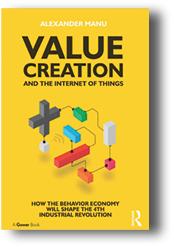 Alexander Manu. 2015. Burlington, VT: Gower Publishing Company. [ISBN 978-1-4724-5181-1. 236 pages, including index. US$119.95.]
Alexander Manu. 2015. Burlington, VT: Gower Publishing Company. [ISBN 978-1-4724-5181-1. 236 pages, including index. US$119.95.]
 Value Creation and the Internet of Things: How the Behavior Economy will Shape the 4th Industrial Revolution is a dense analysis of the way our evolving experiences shape business. It is not an easy read. The overall message is clear and reinforced throughout the book: Behavior will shape change, and the people and companies that embrace changing behaviors will shape the future and leave behind those that continue with the status quo. I started this book expecting a stronger technology focus but found it to explain technology more as a tool to achieve changing potential rather than the change driver. It is an informational book that provides thorough examples and thought-provoking conversation.
Value Creation and the Internet of Things: How the Behavior Economy will Shape the 4th Industrial Revolution is a dense analysis of the way our evolving experiences shape business. It is not an easy read. The overall message is clear and reinforced throughout the book: Behavior will shape change, and the people and companies that embrace changing behaviors will shape the future and leave behind those that continue with the status quo. I started this book expecting a stronger technology focus but found it to explain technology more as a tool to achieve changing potential rather than the change driver. It is an informational book that provides thorough examples and thought-provoking conversation.
Manu separates the book into five sections that transition from identifying potential value to transforming that potential into something viable and attainable that shapes the future. He says we are changing from a somewhat passive economy where we buy goods without engaging with the companies that sell them into a “behavioral economy” that wants to not only buy goods but become part of an experience and contribute to a conversation. You could argue this idea dates back to the beginning of trade—or at least back to Nike’s Air Jordans—but Manu stresses the Internet and social media’s role in consumers’ ability to interact with companies and companies’ abilities to create brand experiences and learn from those experiences. He says, “When inventing things like the World Wide Web or the electric motor, we are not seeking to solve problems, we are searching for a new way of life, for a wide field of possibility that will open up multiple behavior spaces to be imagined and implemented by the ones that come after us” (p. 87).
Next, Manu describes value capture and delivery: how you change the present to make the future. He says there are three categories of development for the Internet of things: enhance our experience of current products/services, expand our relationship and engagement with current products/services, and redefine our relationships through new products/services. Then, guest author Kovalyukh explains that organizations have to find a way for employees to buy into their mission by adopting what is good for the organization, into the value system of the individual. The final section focuses on ideology, leadership, and strategic value together. The authors (Manu and Hastrich, who contributed two chapters) tie the themes from the earlier sections into a discussion about a successful organization. It boils down to a pilot, someone who can lead by being a visionary and make their ideas materialize into the desires for the future.
Filled with examples of companies that created value (Netflix) and ones that missed opportunities (Polaroid), Value Creation and the Internet of Things challenges the reader to examine the drivers, thought processes, and behavioral society that shape technology and the economy as they move from present to future.
Stephanie Saylor
Stephanie Saylor is an STC member and a technical writer at Next Century Corporation. She received her master’s degree in digital communication from Johns Hopkins University. Stephanie is a plain language enthusiast, working mom, advocate for food allergy awareness, and tweets @plainlang.
Facilitating Learning with the Adult Brain in Mind: A Conceptual and Practical Guide
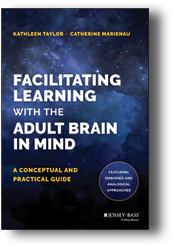 Kathleen Taylor and Catherine Marienau. 2016. Jossey-Bass.[ISBN 978-1-118-71145-3. 400 pages, including index. US$45.00.]
Kathleen Taylor and Catherine Marienau. 2016. Jossey-Bass.[ISBN 978-1-118-71145-3. 400 pages, including index. US$45.00.]
 Understanding how adults learn is important to those who teach and develop courses for adults. In Facilitating Learning with the Adult Brain in Mind: A Conceptual and Practical Guide, the authors describe how the brain works and how to use this knowledge to help adults learn and perform more effectively in a variety of settings.
Understanding how adults learn is important to those who teach and develop courses for adults. In Facilitating Learning with the Adult Brain in Mind: A Conceptual and Practical Guide, the authors describe how the brain works and how to use this knowledge to help adults learn and perform more effectively in a variety of settings.
Taylor and Marienau mention in the preface that they wrote this book because when they went looking for information on recent neurobiological discoveries they could not find information that was easy-to-understand or specifically applicable to adult learning. The authors wrote this book in three parts with the emphasis on Adult Learning Facilitators in Any Setting (ALFAS). Each chapter ends with questions to encourage further reflection and a summary of key points that are very helpful.
In Part One, the authors request that you not skip this section to get to the more “useful stuff” as it deals with brain basics—scientific explanations of how the brain developed in humans; how experience, memory, and emotions create an embodied brain that leads to learning; and how metaphors and analogies help the brain categorize new information and the role of both the right and left hemispheres in the learning process. Using simple illustrations and examples, Taylor and Marienau make this complex information easy to understand and set the stage for the practical information that follows.
Part Two focuses on practices that can encourage and help adult learning. Using a visual metaphor called “Theater of Knowing,” the authors present activities, exercises, and strategies from several practitioners in the field from different parts of the world. The topics range from how to alleviate learner anxiety and how to spark curiosity, to how to encourage reflection and feedback. This part of the book is full of practical ideas with associated explanations of how they relate to the “brain aware” points that were discussed earlier and how they promote learning.
Part Three brings together the information from the first two parts by discussing theories and models from experts in adult development, psychology, and philosophy fields.
Facilitating Learning with the Adult Brain in Mind is a good resource to anyone involved with adult learning. Although it tends to be more scholarly and academic in nature, it includes many practical exercises for use in both academic and corporate learning settings.
Preeti Mathur
Preeti Mathur is an STC Associate Fellow. She is a member of the Twin Cities chapter, Editor/Member Technical Communication Body of Knowledge (TCBOK) and past co-manager for the STC Instructional Design & Learning SIG (IDL SIG). She works as an independent consultant, developing technical training and documentation for several industries.
Risk Communication and Miscommunication: Case Studies in Science, Technology, Engineering, Government, and Community Organizations
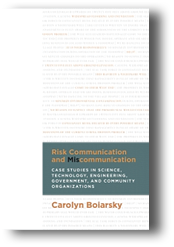 Carolyn R. Boiarsky. 2016. Boulder, CO: University Press of Colorado Press. [ISBN 978-1-60732-466-9. 140 pages, including index. US$20.95 (soft cover).]
Carolyn R. Boiarsky. 2016. Boulder, CO: University Press of Colorado Press. [ISBN 978-1-60732-466-9. 140 pages, including index. US$20.95 (soft cover).]
 Boiarsky dissects communications surrounding environmental and other disasters in the US during the last few decades to show what went wrong (and sometimes right) within the companies and government agencies involved. In the process, she analyzes not only the content of emails and letters leading up to the event in question but also the form and timing of the communication in question. Most of her examples are drawn from internal memos, emails and letters, but some relate to publicly provided information.
Boiarsky dissects communications surrounding environmental and other disasters in the US during the last few decades to show what went wrong (and sometimes right) within the companies and government agencies involved. In the process, she analyzes not only the content of emails and letters leading up to the event in question but also the form and timing of the communication in question. Most of her examples are drawn from internal memos, emails and letters, but some relate to publicly provided information.
This book delves into the communications before the 1992 Chicago flood, the 2011 Mississippi flood, the 2003 Columbia space shuttle breakup, 2010 Deepwater Horizon oil spill in the Gulf of Mexico, the 2012 expansion of the Enbridge pipeline, and persuasive writing by two sides of the controversy over the continued extraction of coal. As Boiarsky acknowledges, not everyone will be familiar with the details of these events. She therefore provides a list of resources, organized by book chapter, that provide additional background on each issue.
While explaining the inappropriate decisions the writers of most of the book’s sample texts made, Boiarsky also offers ideas on how those communications could have been improved, concluding with guidelines for effective PowerPoint presentations—a form of communication many of us deliver not infrequently. Most of us are not involved in projects as large and potentially dangerous as those in this book. Yet we can still learn from these examples how to better shape our own writing to avoid misunderstanding, place appropriate emphasis on key pieces of information, and make sure our message is heard clearly.
One complaint from this reviewer: The sample texts are included as relatively small images that are hard to read. Larger images or inclusion of the samples’ content within the text of the book—perhaps as sidebars—would have been helpful for following and evaluating Boiarsky’s arguments.
As I write this, the US just elected its 45th president. Messaging—both overtly and implicitly—played an important role in the campaigns leading up to the election. We would do well to critically examine what our own writing communicates or implies and whether it places appropriate weight on the points we want to make. As communication professionals, we need to counter demagoguery with clear, concise, and audience-focused reasoning.
Barbara Jungwirth
Barbara Jungwirth owns reliable translations llc (www.reliable-translations.com), where she translates technical documents from German into English. She was previously a technical writer and IT manager and currently serves on the board of STC’s New York Metro chapter. Barbara writes a blog (On Language and Translation) and tweets (@reliabletran).
Please Make This Look Nice: The Graphic Design Process
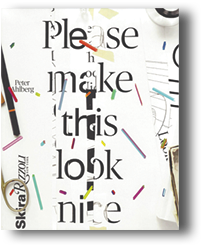 Peter Ahlberg. 2016. New York, NY: Skira Rizzoli. [ISBN 978-0-8478-4834-8. 272 pages, including index. US$39.95 (softcover).]
Peter Ahlberg. 2016. New York, NY: Skira Rizzoli. [ISBN 978-0-8478-4834-8. 272 pages, including index. US$39.95 (softcover).]
 Description from the Drawing Center website: “Equal parts design inspiration and manual, Please Make This Look Nice combines interviews, writings, case studies, and personal ephemera from celebrated designers into a solid primer for designers and design enthusiasts alike.”
Description from the Drawing Center website: “Equal parts design inspiration and manual, Please Make This Look Nice combines interviews, writings, case studies, and personal ephemera from celebrated designers into a solid primer for designers and design enthusiasts alike.”
This book may or may not become a teaching tool, but this non-designer found it to be an engaging excursion through the current graphic design culture. My work is in documentation and procedures, with graphics work limited to screen shots and flow charts. Those are useful elements, but having a guided tour through a wider section of the visual communication world is exciting.
Ahlberg presents his multiple sources in a coherent, connected flow throughout the book with a relaxed, conversational tone. He has edited the conversations and essays of 21 designers so that each designer’s voice is present in his or her article. The author divided the book into four broad topics: Writing/Drawing, Prototypes/Tools/Photography, Assemblage/Mechanicals, and Objects/Works/Studios. Some articles address more than one section; these are placed to maintain the overall sequencing. Brief headings in each article signal a change of topic, but the transition from one thought to the next is very smooth and logical.
These successful designers work solo, in partnerships, in teams, and in studios. They describe how they find the ideas that meet their client’s expectations and demands, which tools and environments suit their working styles, their experiences from the roots of modern graphics design and its future with and without technology. Not unexpectedly, each designer’s definition and description of the design process is unique.
Please Make This Look Nice has a strong physical presence. Although it is softcover, the paper is heavy and glossy to best present the illustrations that are more than half the page count. The three-column layout of the text pages, with titles on the left and section titles floating on the right, makes it easy to relate the article to its topic. There is enough negative space on each page to avoid fatigue.
The front and back inside cover design references a concept of design described in the Introduction, which summarizes the designer’s evaluation of that concept.
The illustrations vary—notebook sketches, first concept drawings, finished designs, photographs of designer’s studios and photo shoot set-ups. There are collages and prints. As I read an article, I used the index to find that designer’s work in the illustrations section. Tying the verbal and visual together made it easier to understand the designer’s point.
Do not try to read this book in one sitting. Skim the text, explore the graphics, and then choose a section. Enjoy these fascinating, inspiring conversations. You will take away a deeper understanding of graphics designers and graphic designers (yes, there is a difference!).
Marcia Shannon
Marcia Shannon, CPTC-Foundation, is a current STC member and Secretary for the IDL SIG. Her 30+ years of business experience cover IT, mortgage, banking, and insurance. She has written procedures, taught them, and provided user support in each field. Currently, she writes and edits procedures and job aids, and coaches non-writer co-workers.
Deep Text: Using Text Analytics to Conquer Information Overload, Get Real Value from Social Media, and Add Big(ger) Text to Big Data
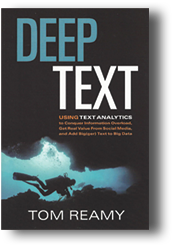 Tom Reamy. 2016. Medford, NJ: Information Today, Inc. [ISBN 978-1-57387-529-5. 424 pages, including index. US$59.50 (softcover).]
Tom Reamy. 2016. Medford, NJ: Information Today, Inc. [ISBN 978-1-57387-529-5. 424 pages, including index. US$59.50 (softcover).]
If an organization has thousands of customer reviews of its XYZ product, how do they determine if the product is a success based on feedback? One way is by data mining. The problem, according to Reamy’s Deep Text: Using Text Analytics to Conquer Information Overload, Get Real Value from Social Media, and Add Big(ger) Text to Big Data, is that data mining software would give you the same results from “I love XYZ product” and “I would love XYZ product if it had ABC features.” The distinction could come by using text analytics.
One way to look at text analytics is that it imposes structure on unstructured text. The complexity increases with data mining and beyond. Text analytics represents a final complexity for Reamy. Text analytics combines data mining with semantics or pragmatics.
Many organizations are having difficulty with the volume of text. From sticky notes to formal and informal documents to electronic texts, they store it but then what? Small amounts of text can be handled by simple searches by hand or computer. Even modest amounts of text can be processed by dictionary and thesaurus software. Now, data mining software can handle larger amounts of text. But these methods, while efficient at the word and phrase levels rely on human intervention to extract full meaning.
Reamy’s Deep Text offers a way to extract meaning; text analytics goes beyond data mining to give organizations a tool that allows them to make the most use of the texts they have accumulated.
Text analytics is a complex approach that almost defies definition. Yet, Reamy tries: “… the use of software and content models (taxonomies and ontologies) to analyze text and the applications that are built using this analysis” (p. 5). Deep text becomes “an approach to doing text analytics, and . . . the kinds of applications that can be built using this approach” (p. 375). From this expanded definition, he develops both his case for using text analytics and hints on building and using it. Reamy divides his presentation’s 15 chapters into five parts (each containing three chapters), and adds a conclusion, two appendices, a bibliography, a short biography, and an index.
After an introduction, Part One explains text analytics basics, Part Two offers suggestions on getting started, Part Three discusses text analytics development, Part Four shows applications, and Part Five discusses text analytics in the enterprise. Appendix A is a series of questions you can ask to help design a text analytics solution, and Appendix B lists 32 text analytics companies as well as 18 free text analytics and text mining software products.
Text analytics is complex and not for the faint of heart. Yet, organizations must find a way to extract information they need from the texts they accumulate. Reamy’s Deep Text should encourage you to pursue text analytics rather than look somewhere else for solutions.
Tom Warren
Tom Warren is an STC Fellow, Jay R. Gould Award for Excellence recipient, and professor emeritus of English (technical writing) at Oklahoma State University, where he established the BA, MA, and PhD technical writing programs. Past president of INTECOM, he served as guest professor at the University of Paderborn, Germany.
Clinical Communication in Medicine
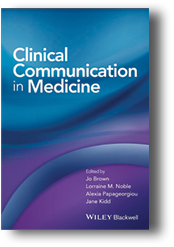 Jo Brown, Lorraine M. Noble, Alexia Papageorgiou, and Jane Kidd, eds. 2016. West Sussex, UK: Wiley Blackwell. [ISBN 978-1-118-72824-6. 264 pages, including index. US$60.00 (softcover).]
Jo Brown, Lorraine M. Noble, Alexia Papageorgiou, and Jane Kidd, eds. 2016. West Sussex, UK: Wiley Blackwell. [ISBN 978-1-118-72824-6. 264 pages, including index. US$60.00 (softcover).]
n the medical field, clinical communication is often taught on the job. Jane Kidd, one of the editors of Clinical Communication in Medicine, feels that this is a concern because “students learn simply to copy certain statements or behaviours, without a deep understanding of which approaches are effective and why” (p. 1). This book remedies this lack of understanding by exploring the theoretical underpinnings in three areas: the doctor–patient relationship, clinical communication components, and effective teaching and assessment strategies (p. 1).
Clinical Communication in Medicine is divided into three sections, each tackling one of these areas. Although the book’s organization is modular by allowing the reader to review the chapters in any order, the chapters follow a logical sequence that progresses from the most basic information to the more complex issues in clinical communication. Similarly, the chapters themselves follow this “given-new contract.” Each chapter begins with an exploration of information that is known about the topic before delving into a discussion of new directions and current research. This structure allows even novice students to learn about the topic under discussion, from its most basic principles to the most current applications.
The book’s authors focus primarily on communication theory and medical history to draw the reader into a greater understanding of how current best practices in clinical communication have evolved. Although the explanations of the theories and practices are outlined clearly and in language that the average graduate or medical student could understand, many authors used excessive passive voice, which I found distracting. As a technical communicator who often writes for the medical fields, I know the importance of active voice and simple language when communicating with patients. Ironically, Clinical Communication in Medicine does not contain any chapters or information specifically tied to written clinical communication, which some of the authors might have benefitted from.
Most of the discussion within the book is applicable to clinical communication in medical settings worldwide. However, since the majority of the authors are from the UK, the book’s focus centered on the reality of the National Health Service (NHS) and other UK-based medical contexts. For example, “Chapter 3: The History of the Doctor–Patient Relationship” discusses the evolution of the view of healthcare as a human right, which is arguably not the way healthcare is seen in the United States or other countries without a socialized medical system.
Despite a slight bias toward medicine in the UK and some unnecessarily wordy language, Clinical Communication in Medicine is a timely, well-organized, and thoughtful text that will be useful to a broad audience of graduate students, medical students, academics in the communication fields, and medical professionals. The book’s focus on the clinical context and the skillful weaving together of history, theory, and current practice meet the editors’ goal of helping the reader understand the “whys” of clinical communication, as well as the “how-to’s.”
Nicole St. Germaine-Dilts
Nicole St. Germaine is an Assistant Professor in the Technical and Business Writing Program at Angelo State University, as well as a freelance writer and consultant. Her research interests include technical communication for a Mexican-American audience and technical communication in the health fields.
Best Practices for Knowledge Workers: Innovation in Adaptive Case Management
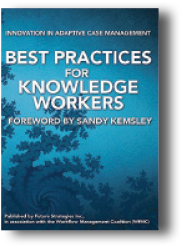 Layna Fischer, ed. Lighthouse Point, FL: Future Strategies, Inc. [ISBN 978-0-9863214-4-3. 257 pages, including index. US$40.00 (e-book).]
Layna Fischer, ed. Lighthouse Point, FL: Future Strategies, Inc. [ISBN 978-0-9863214-4-3. 257 pages, including index. US$40.00 (e-book).]
 This comprehensive book should be on the reading list of people working in Knowledge Management (KM), Human Resources, Analytics, and Business Process Management (BPM). Divided into two sections, Section 1 focuses on Knowledge Work and Case Management while Section 2 includes case studies ranging in topic from electronic documentation at the National Institute of Allergy and Infectious Diseases to Universal Forest Products’ enterprise content management system. There is a bonus chapter on automated case management best practices for those accessing the digital version.
This comprehensive book should be on the reading list of people working in Knowledge Management (KM), Human Resources, Analytics, and Business Process Management (BPM). Divided into two sections, Section 1 focuses on Knowledge Work and Case Management while Section 2 includes case studies ranging in topic from electronic documentation at the National Institute of Allergy and Infectious Diseases to Universal Forest Products’ enterprise content management system. There is a bonus chapter on automated case management best practices for those accessing the digital version.
The Workflow Management Coalition (WfMC) and BPM.com co-sponsor WfMC Awards for Case Management “designed to highlight the best examples of technology to support knowledge workers” (p. 16). The eight case studies in Section 2 are award winners. Each case study is presented in a standard format making it easy for readers to find the business context, the key innovations, hurdles overcome, key benefits, and the best practices. Included graphics also benefit the reader through interesting figures, tables, and charts that make the content lively. If your reading time is limited, reading the overview, best practices, and conclusion sections will provide you with a significant amount of information letting you decide on which topic or chapter to devote more time. The content is so well-organized that it is easy to extract the needed information.
Recruiters and managers of knowledge workers will find ideas to motivate staff, improve processes, and adapt social collaboration practices. Information technology enthusiasts will see how data mining and analytics can benefit knowledge workers for greater organizational efficiencies. Business process gurus will value the case study examples of processes in practice and can avoid pitfalls experienced by others implementing or revamping procedures.
Best Practices for Knowledge Workers: Innovation in Adaptive Case Management is truly a one-stop shop for best practices and relevant case studies on the interconnected fields of KM, BPM, and analytics. It focuses on the knowledge worker while also presenting the customer perspective giving readers a well-rounded viewpoint.
Liz Herman
Liz Herman, PhD, is a knowledge management practitioner and is certified in project management and technical communication. She is an STC senior member and active in STC’s Washington DC Chapter. She currently works for Battelle in its Health and Analytics business unit.
Successes and Failures of Knowledge Management
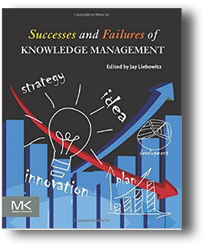 Jay Liebowitz, ed. 2016. Cambridge, MA: Morgan Kaufmann. [ISBN 978-0-12-805187-0. 232 pages, including index. US$59.95 (softcover).]
Jay Liebowitz, ed. 2016. Cambridge, MA: Morgan Kaufmann. [ISBN 978-0-12-805187-0. 232 pages, including index. US$59.95 (softcover).]
n Successes and Failures of Knowledge Management, Tsui—author of Chapter 6, Lessons Learned from Nearly 200 Cases of KM Journeys by Hong Kong and Asian Enterprises—reminds us that most organizations are not starting their knowledge management (KM) journeys from scratch. Similarly, readers of this book are most likely not KM novices. They come to this book battle-tested and seeking the stories that help them better understand the nuances and complexities of implementing KM programs and learn from other KM failures. They want to compare their experiences with experts in the field. They want to pick and choose the topics that most interest them in their KM journey. Liebowitz pulls together a variety of topics that appeal to those teaching KM and those practicing KM through the inclusion of relevant case studies and discussion around new technologies.
One standout chapter with universal appeal to all readers is written by Ribiere and Calabrese on the enduring struggle with KM implementation. The authors surveyed 34 KM experts and identified through text mining the categories where KM implementations hit roadblocks. The resulting categories are not surprising—culture, measurement and benefits, strategy, organizational structure, governance, IT-related issues, and lack of KM understanding/standards—and serve to reaffirm that there continues to be work (both research and practice) done in the field. The tremendous benefit from this chapter is that readers now have the names and affiliated organizations of 34 KM experts from which to draw information and resources. The list of references after each chapter is also helpful and can remind those immersed in the more operational aspects of KM to reconnect with seminal KM authors (like Thomas Davenport) who have recent work.
KM academics may see affirmations and extensions of their work. Levallet and Chan, discussing knowledge loss and retention, reference de Holan and Phillips’ 2004 model of organizational forgetting. The adoption of this model to work in 2016 demonstrates the value and reach of KM research to those adding to KM’s still relatively small book of knowledge. KM academics may also recognize weaknesses in the research. A case study, for example, conducted by Larson involved findings that lacked linkage with the organization’s key performance indicators and metrics. Although a weakness in one case study, other research discussed in the book does emphasize the importance of linking KM results to an organization’s performance.
Those in KM will benefit from reading Successes and Failures of Knowledge Management. It addresses the current state of KM, confirms the existing body of knowledge, and provides ideas for how to close informational gaps with future research.
Liz Herman
Liz Herman, PhD, is a knowledge management practitioner and is certified in project management and technical communication. She is an STC senior member and active in STC’s Washington DC Chapter. She currently works for Battelle in its Health and Analytics business unit.
There’s Not an App for That: Mobile User Experience Design for Life
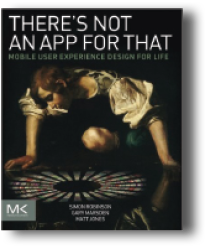 Simon Robinson, Gary Marsden, and Matt Jones. 2015. Waltham, MA: Morgan Kaufmann. [ISBN 978-0-12-416691-2. 418 pages, including index. US49.95 (softcover).]
Simon Robinson, Gary Marsden, and Matt Jones. 2015. Waltham, MA: Morgan Kaufmann. [ISBN 978-0-12-416691-2. 418 pages, including index. US49.95 (softcover).]
There’s Not an App for That: Mobile User Experience Design for Life seeks to answer the not-so-age-old-question: Is my app idea any good? The authors correctly identify the much-lowered threshold for creating mobile apps as a driving force in the birth of thousands of new apps every year. They strongly critique tendencies in current mobile design to encourage what they call “heads-down thinking” or the design of mobile apps that discourage interaction with the real world (p. 17). They argue that mobile app designers can do a better job at accommodating the real people who user their applications.
Specifically, the authors identify six problems with current mobile design thinking: touch-screen dominance; heads-down thinking; clinical helpfulness; calm, understated interactions; stuck in the cloud(s); and design for the few. For each problem, the authors encourage “alternative trajectories for mobile user experience design” (p. 26). In Chapter 7, for instance, which is a response to the “heads-down thinking” problem, the authors wonder what it would be like to design apps that are “face-on,” or “giving your users more of a chance to maintain eye contact with the world around them” (p. 130).
For each of the six problems, the authors suggest multiple possible solutions, some of which seem extravagant (such as a system that allows users to turn pieces of digital “paper” on a touch screen), but all of which are thought-provoking (p. 79). There’s Not an App for That is arguably more about exploring the future of mobile design and providing bold directions for innovative thinking than it is about the how-to minutiae of mobile design. At the same time, every example is either a) an existing mobile application, or b) a prototype application that has been tested in a lab. This gives the book additional credibility for some of the more out-of-the-box solutions, like “ultrahaptics” or air vibrations that give users the sense of an object under their fingers (p. 122).
There’s Not an App for That is a book for practitioners, researchers, and students who want a glimpse at possible futures for mobile app design, or who agree with the authors’ assertion that “heads-down thinking” is not the optimal approach for mobile user experience. Though I personally found the book intriguing, I wondered about the feasibility of many of the suggested alternatives. Just because an interaction is technologically possible in a lab or other limited environment doesn’t mean that it can or will ever see widespread use. However, perhaps I, too, am guilty of “heads-down thinking” and could do with a dose of alternatives to traditional touchscreens, addictive apps, and complex smartphone interfaces that keep me tuned out of my surroundings.
Guiseppe Getto
Guiseppe Getto is a faculty member at East Carolina University. He is also President and Co-Founder of Content Garden, Inc., a digital marketing and UX consulting firm.

